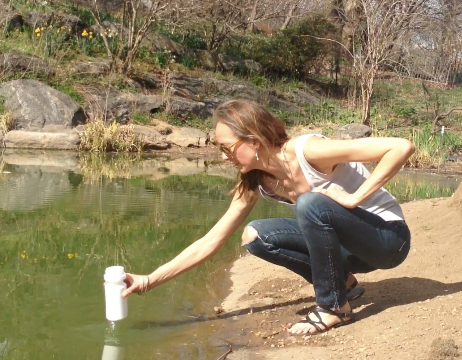Yesterday, I took a small group of college students and schoolteachers on a water-gathering journey around New York City. What if our household taps ran dry without warning, like they do for millions of people with “improved” water supplies every day? Where would we get our water if we didn’t know when the taps would be back on?
Hypothetically water-stressed, we set out on foot to find a workable water source, braving the slimy rocks down to the Hudson River, the angry geese in Harlem’s Morningside Park, and the crowds of joggers and sunbathers in Central Park to collect water. Our participants were shocked at the smell, the open sewage draining into the Hudson, and the difficulty of transporting the water home to boil (so it could be safe) without interacting with the germs on the water bottles.
60% of infant mortality is related to unclean water, and yet water-related aid spending is at a 20-year low. The day collecting water in Manhattan was an effort to bridge the gap in knowledge about water access. One of the greatest challenges in the international effort to alleviate water-related health problems is that water stress is not easily comprehended by people who have never experienced it—which is especially troubling given that most scientists and policy-makers working to address the global burden of disease caused by water stress are from communities with stable, safe water infrastructure. So, what does water stress look like?
An estimated 884 million people worldwide, most of whom live in Sub-Sahara African countries, do not live anywhere close to an improved water source. Families depend on mostly women to walk 1-6 km a day to carry large, heavy containers of water for household use. In urban areas, some people use expensive, trucked-in water that is often from unsafe sources and disreputable vendors. Purchased and carried water is too valuable for anything but drinking, so standing water from ditches, rivers, and ponds is used for washing.
The good news is there has been progress in bringing water closer to homes. Last month, UNICEF’s Joint Monitoring Programme reported, “between 1990 and 2008 an estimated 1.77 billion people gained access to improved sources of drinking water.” The bad news is many of these sources still require a long walk, a significant number have fallen into disrepair, and most are not monitored for contamination. Due to low system capacity, middle-income urban areas with improved (but not necessarily monitored), piped water supplies can only run the taps for a few hours a day. As a result, most households store their water in tanks, if they can afford them, or in open containers, both of which are further sources of contamination. Rural communities with an improved water source typically rely on a shared tap from a covered spring or well, itself vulnerable to contamination and frequent outages—again driving people to open water sources.
At each of the four water sources visited in New York City, we tested the water for contaminants with a cheap and easy water test I am piloting with mWater. The E. coli results were amazing. The Hudson River at the 125th Street fishing pier and the pond in Morningside Park were dangerously contaminated, registering several hundred E. coli per 100 ml of water. Central Park’s pond in the North Woods and the Jacqueline Kennedy Onassis Reservoir, New York City’s water source for 131 years until it was decommissioned in 1993, were moderately contaminated. Being surrounded by two rivers and multiple fresh water sources does not save a community from water stress, and yet most improved drinking water sources are unreliable. If New York City had the periodic outages that most of the world experiences, they would also have to turn to unsafe water for daily use.



